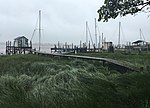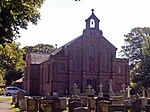Shard Bridge

Shard Bridge is a bridge in the English county of Lancashire. It spans the River Wyre, connecting Singleton, on the southern side of the river, to Hambleton, on its northern side (an area known locally as "Over Wyre"), carrying both automotive and pedestrian traffic of Shard Road (the A588). The word shard is a Roman term for "low crossing point on a river".The original bridge was built in 1864, and it went on to replace a ferry service between Stanah and Wardleys Creek further downstream to the west. The bridge was moved a few yards downstream in 1993 when the first of its two current iterations was constructed. Formerly a toll bridge, Shard Bridge is now a free municipal crossing.
Excerpt from the Wikipedia article Shard Bridge (License: CC BY-SA 3.0, Authors, Images).Shard Bridge
Shard Road, Borough of Wyre Hambleton
Geographical coordinates (GPS) Address External links Nearby Places Show on map
Geographical coordinates (GPS)
| Latitude | Longitude |
|---|---|
| N 53.862 ° | E -2.9625 ° |
Address
Shard Bridge
Shard Road
FY6 9BU Borough of Wyre, Hambleton
England, United Kingdom
Open on Google Maps









